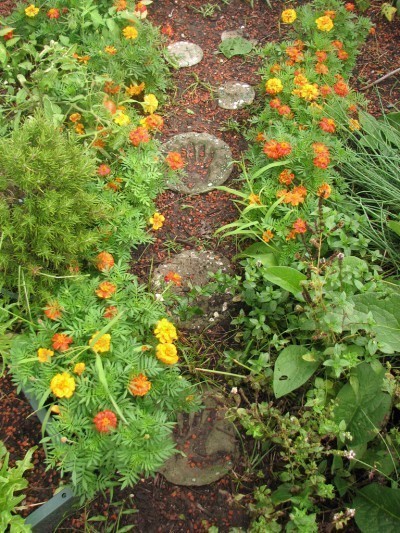
Color schemes should be chosen carefully in order to complement the home and surrounding landscape. The use of a color wheel is ideal for choosing color combinations that complement one another. For instance, analogous colors, which are side by side on the color wheel, are soothing when planted together. Complementary colors, which appear opposite one another, are bold and exciting when grouped together.
Hot or bright colors such as red, yellow, and orange bounce forward and are best placed at a distance. Cool colors, like blue and lavender, tend to fall back and are best suited up close for a restful effect. Lighten up darker areas with white and soft pastels. Since darker reds and purples can appear ominous, they should be incorporated into bright areas.
Do not overlook foliage color; they also provide interest. Various colors, textures, and shapes of both flowers and foliage create contrast, providing depth and personality to the garden. When proper design features are implemented, the flowers and foliage will not only harmonize with one another, but they will complement the surrounding landscape as well.
Additional Garden Design Features
Other garden design features include accessories, paths, and backdrops.
- Accessories – Adding garden accessories such as benches, water and stone features, urns, statues and other ornamental objects will enliven the garden, drawing attention to it; however, these should be used sparingly to avoid a cluttered appearance. Accessories should also match the style of the garden.
- Paths – Paths provide additional interest. They can be formal and straight or informal and meandering. Winding paths throughout a long garden will reduce length. As with other garden features, paths should also match the style. For example, mulch used for garden paths (or the garden itself) should blend in. Wood chips fit in well with natural settings, while fieldstone or brick are best suited to gardens that are more formal.
- Backdrops – Backdrops, such as walls, fences, and hedges can provide privacy, hide unsightly areas or emphasize desired views. Adding height with structures such as trellises, arbors, or larger architectural plantings will give the landscape additional depth and variety.
Garden Design Styles
Most gardens employ at least one of three design styles: formal, informal, or naturalistic.
- Formal – Formal gardens possess a sense of order, containing straight lines with symmetrical plantings. Features may include low walls, elegant sculptures or fountains, and minimal plantings with well-groomed hedges. Formal gardens are well suited for urban areas where space may be limited.
- Informal – Informal gardens have an unbalanced, yet relaxing appeal, consisting of curves and asymmetrical plantings. Features include mixed plantings of fruits, vegetables, and herbs with a variety of flowering plants. They may also contain romantic structures such as gazebos, arbors, or picket fences along with some type of water feature.
- Naturalistic – Naturalistic gardens are untamed and informal. Groupings of native plants and wildflowers, informal paths, and various water features that mimic nature can all be found within these gardens.
Designing a garden does not have to be difficult or costly. Don’t feel limited to strict rules or particular plants. Use your imagination, experiment and play around with design schemes that work for you and your landscape. As long as you employ careful planning beforehand, you can create a beautiful garden anywhere, regardless of expertise.






